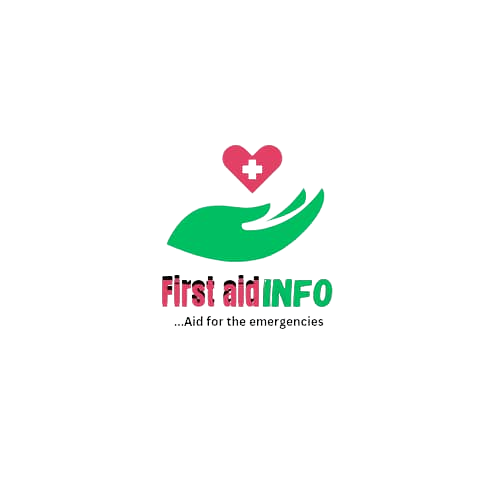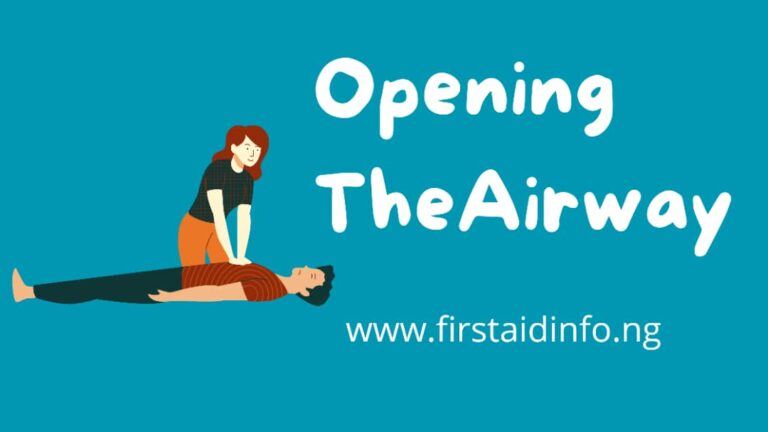You would notice that we have written about different first aid techniques, and opening the airway technique is one of them, our goal at www.firstaidinfo.ng is to make sure you have the necessary first aid information you require to save a life when the need arises, or simply knowing where to go when you require guidance to help save a life.
Technique – Opening the airway
1. Kneel beside the person’s chest.
2. Put one hand on the forehead of the person. Gently press it down and tilt their head back.
3. Put two fingertips of your other hand beneath the person’s chin, but do not push into the soft part of the chin. Lift the chin to open the airway.
When you suspect a spinal injury, do not tilt the person’s head back. In this case, you only perform the chin lift.
Technique – Check for breathing

While keeping the person’s airway open, bring your ear close to their mouth.
■ Look to see if the chest goes up and down.
■ Listen at the mouth and nose for breathing sounds.
■ Feel with your cheek if there is air flow.
Looking, listening and feeling are done simultaneously and should not take longer than 10 seconds. However, it should be done long enough, because an unconscious person may breathe slowly. If you do not check the breathing for long enough, you may incorrectly assume that the person is no longer breathing.
Attention! – Gasping
In the first few minutes after a cardiac arrest, it often looks like the person is still trying to breathe. The person could make (sometimes noisy) breathing movements, but there is no detectable air flow at the nose and mouth. The person may make involuntary movements with the arms and legs. This is called ‘gasping’ and should be categorized as ‘not breathing normally’. CPR must be started immediately
In emergency first aid situations, maintaining an open airway is a critical first step. Without a clear airway, a person’s ability to breathe can be compromised, leading to potentially life-threatening consequences. This blog post will provide a detailed guide on how to open the airway in various first aid scenarios, ensuring you have the knowledge and skills to respond effectively.
Understanding the Importance of a Clear Airway
An open airway is vital for breathing and oxygen exchange, making it the top priority in first aid. Without adequate oxygen, the brain and other vital organs can become damaged within minutes. Key points to understand about the importance of a clear airway include:
Oxygen Supply: Oxygen is essential for the body to function. Without it, cells can die, leading to severe consequences.
Brain Function: The brain is highly sensitive to oxygen deprivation, and even a brief interruption in oxygen supply can result in irreversible damage.
Respiratory Obstruction: Various factors can obstruct the airway, such as foreign objects, swelling, or trauma.
Initial Assessment Of Airway Obstruction
Before taking any action, it’s essential to conduct an initial assessment to determine the person’s condition.
Key steps in the initial assessment include:
Scene Safety: Ensure that the environment is safe for both you and the victim. Assess for potential hazards.
Victim’s Responsiveness: Gently tap or shake the person and ask if they are okay. Look for signs of responsiveness, such as speaking or moving.
Breathing Check: Observe the victim’s chest for breathing. Listen for sounds of breathing and feel for exhaled air on your cheek. This is a crucial step in determining the need to open the airway.
Techniques for Opening the Airway
If the victim is unresponsive and not breathing normally, you must open the airway. There are several techniques to achieve this:
Head-Tilt, Chin-Lift Manoeuvre
Position: Kneel beside the victim.
Hand Placement: Place one hand on the victim’s forehead and two fingers of your other hand under their chin.
Action: Gently tilt the head backward while lifting the chin forward. This manoeuvre helps align the airway for improved breathing.
Assessment: Once the airway is open, check for breathing by listening and feeling for air.
Jaw-Thrust Manoeuvre
This technique is used when there is a suspicion of a neck injury.
Position: Kneel beside the victim’s head.
Hand Placement: Place your fingers behind the angle of the victim’s jawbone.
Action: Gently lift the jaw forward without moving the neck.
Assessment: Check for breathing as mentioned earlier.
Additional Considerations
In some situations, the victim may have an obstructed airway due to a foreign object, fluids, or other factors. Here are some additional considerations:
Choking: If a victim is choking, perform abdominal thrusts (Heimlich manoeuvre) to dislodge the obstruction.
Clearing the Airway: In cases where you suspect an object is blocking the airway, use your fingers to carefully sweep out the blockage.
Special Situations: When dealing with infants or small children, adjust your techniques to accommodate their size and fragility.
Conclusion
Opening the airway is a fundamental skill in first aid that can be a lifesaver. Understanding the importance of a clear airway, conducting an initial assessment, and employing proper techniques like the head-tilt, chin-lift or jaw-thrust manoeuvre are essential components of providing effective first aid. With this knowledge, you can be better prepared to respond to emergency situations and help those in need. Always remember to seek professional medical assistance when available, and keep your first aid skills up to date through training and practice.
Please share


